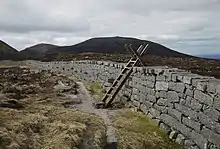Belfast City and District Water Commissioners
The Belfast City and District Water Commissioners was a public body in northern Ireland, established by the Belfast Water Act 1840, to improve the supply of water to the expanding city of Belfast. By 1852, the city was suffering a shortfall in supply of almost one million gallons per day.[1][2]


In 1891, the Commissioners appointed local civil engineer, Luke Livingston Macassey to identify water resources to sustain Belfast.[3] Five potential sites were surveyed in County Down, and County Antrim. Macassey ultimately decided on the Mourne Mountains in Down. Upon deciding on the site, water commissioners agreed on securing a 9,000-acre (3,600 ha) catchment area. Private Acts of Parliament (in 1893, 1897 and 1899) allowed the purchase of the Mournes land and related access permits and water rights.[3] At the time the catchment was capable of providing some 30 million imperial gallons (140,000 m3) of water per day, but this was too much. A scheme was developed and divided into three phases.
The first stage was to divert water from the Kilkeel and Annalong river through pipes to a reservoir near Carryduff. These water pipes were capable of supplying 10 million imperial gallons (45,000 m3) of water per day. Work was completed in 1901.[3] The second stage was to build a storage reservoir, the Silent Valley Reservoir, across the Kilkeel River, after new pipes laid there were able to supply another 10 million imperial gallons (45,000 m3) of water per day. Design work on this phase began in 1910, but procurement of the work was delayed by World War I. A contract was eventually awarded in 1923 to S. Pearson & Son and work continued until 1933.[4]
The commissioners were responsible from 1914 for the construction of the Mourne Wall which Northern Ireland Water began to restore in 2017.[5]
Before the Second World War, the commissioners purchased a building that is still known as the Water Office.[6][7][8]
In the later 20th century, responsibility for providing water services was transferred to central government in Northern Ireland and, eventually, to Northern Ireland Water.
References
- Short History of Belfast’s Mourne Water Supply. William R Darby, EARC, 2 November 2010. Retrieved 29 January 2018.
- Luke Livingstone Macassey (1843 - 1908). Patrick Devlin, Dictionary of Ulster Biography. Retrieved 29 January 2018.
- "A Century of Water from the Mournes - a concise history". BBC News. 16 October 2014. Retrieved 25 June 2020.
- "A Century of Water from the Mournes - Part 2 A concise history - The Silent Valley Reservoir - 1910 - 1933". BBC News. 16 October 2014. Retrieved 25 June 2020.
- 113 years on, work begins to repair the wonder wall of the Mournes. Allan Preston, Belfast Telegraph, 20 May 2017. Retrieved 29 January 2018.
- The Water Office. Culture Northern Ireland. Retrieved 29 January 2018.
- HB26/50/015. Department for Communities. Retrieved 29 January 2018.
- Richardson & Owden's Warehouse. Victorian Web, 13 September 2006. Retrieved 29 January 2018.
External links
 Media related to Belfast City and District Water Commissioners at Wikimedia Commons
Media related to Belfast City and District Water Commissioners at Wikimedia Commons